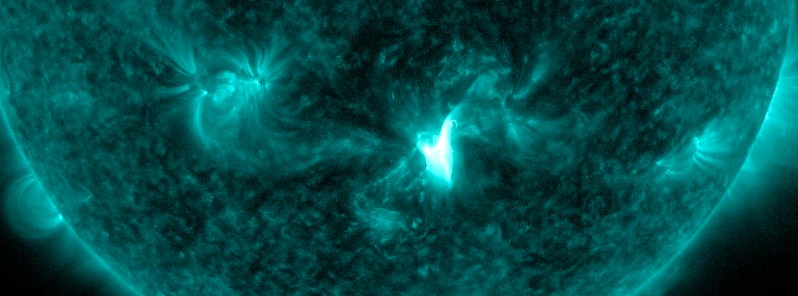Long-duration C7.4 solar flare produces asymmetric full halo CME, impact expected on December 9

A long-duration solar flare measuring C7.4 at its peak erupted from Active Region 2790 — positioned in Earth-striking zone — at 16:32 UTC on December 7, 2020. The event started at 15:46, peaked at 16:32, and ended at 17:33 UTC. An asymmetric full halo coronal mass ejection (CME) was produced, with a likely Earth-directed component arriving on December 9.
The flare was associated with an approximately 9 degree long, N-S aligned disappearing solar filament that bisected the southern extremity of the region's magnetic neutral line.
Additionally, the flare was associated with a 180 sfu Tenflare at 16:43 UTC.
There was also some minor coronal dimming, post-flare coronal looping, and an EIT wave observed in GOES/SUVI 195A imagery.
"A consensus of model runs suggest speeds between 830 – 880 km/s, and arrival in the latter half of December 9," SWPC forecasters said at 00:30 UTC on December 8.

Solar activity is expected to be at very low levels through December 10, with a chance for C-class flares on December 8 and a slight chance on December 9 and 10, due primarily to the activity tendency of Region 2790.
The greater than 2 MeV electron flux was normal to moderate and the greater than 10 MeV proton flux remained at background levels in 24 hours to 00:30 UTC on December 8.
The greater than 2 MeV electron flux is expected to be normal to moderate levels through December 10, while the greater than 10 MeV proton flux is expected to continue at background levels.
Solar wind parameters were indicative of a slow, low-density regime in 24 hours to 00:30 UTC today.
Total IMF strength ranged primarily from 2 to 7 nT and the Bz component underwent mainly weak deviations. Solar wind speed averaged 350 – 400 km/s and the phi angle was predominantly positive.
The solar wind is anticipated to continue as primarily a slow regime on December 8.
Elevated conditions are likely on December 9 and 10 with the combined influence of a weak, negative polarity CH and arrival of a CME from the December 7 event.

The geomagnetic field was quiet and is expected to remain primarily quiet on December 8.
A G1 – Minor storm conditions are likely on December 9 and 10 due to the combined effects of a weak, negative polarity CH and the arrival of a CME from the December 7 event.
Update
A G1 – Minor geomagnetic storm watch is in effect for December 9, G3 – Strong for December 10, and G2 – Moderate for December 11, SWPC said at 15:06 UTC today.
Potential Impacts: Area of impact primarily poleward of 50 degrees Geomagnetic Latitude.
Induced Currents – Power system voltage irregularities possible, false alarms may be triggered on some protection devices.
Spacecraft – Systems may experience surface charging; increased drag on low Earth-orbit satellites and orientation problems may occur.
Navigation – Intermittent satellite navigation (GPS) problems, including loss-of-lock and increased range error may occur.
Radio – HF (high frequency) radio may be intermittent.
Aurora – Aurora may be seen as low as Pennsylvania to Iowa to Oregon.
Featured image credit: NASA/SDO AIA 131

Sorry 2020 I’m done being scared
You should check into Suspicious Observers on youtube, Ben Davidson and hundreds of citizen scientists devoting the most advanced approach studying the sun and the effects it has on the earth, particularly human health and causation of earthquakes and volcanic eruptions. Cheerio.
Oh boy…. it’s a big, monster, ginormous….. Nothing!
It’s a solar minimum…. this isn’t an X flare or even an M class flare… but be very afraid!
LOL
When you read https://astronomy.com/news/2020/07/powerful-eruptions-on-the-sun-might-trigger-earthquakes
and with the article A long-duration solar flare measuring C7.4 at its peak erupted from Active Region 2790 — positioned in Earth-striking zone — at 16:32 UTC on December 7, 2020.
Then is the result https://earthquake.usgs.gov/earthquakes/map/?extent=21.61658,-130.16602&extent=52.02546,-59.85352&sort=largest
Very serious, the atmosphere and the core of the Earth is highly saturated at the present time, and this solar event which is seems to be earth directed will generate further severe energetic events, like severe geological and weather events